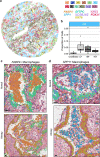This is a preprint.
Image-based spatial transcriptomics identifies molecular niche dysregulation associated with distal lung remodeling in pulmonary fibrosis
- PMID: 38168317
- PMCID: PMC10760144
- DOI: 10.1101/2023.12.15.571954
Image-based spatial transcriptomics identifies molecular niche dysregulation associated with distal lung remodeling in pulmonary fibrosis
Update in
-
Spatial transcriptomics identifies molecular niche dysregulation associated with distal lung remodeling in pulmonary fibrosis.Nat Genet. 2025 Mar;57(3):647-658. doi: 10.1038/s41588-025-02080-x. Epub 2025 Feb 3. Nat Genet. 2025. PMID: 39901013 Free PMC article.
Abstract
The human lung is structurally complex, with a diversity of specialized epithelial, stromal and immune cells playing specific functional roles in anatomically distinct locations, and large-scale changes in the structure and cellular makeup of this distal lung is a hallmark of pulmonary fibrosis (PF) and other progressive chronic lung diseases. Single-cell transcriptomic studies have revealed numerous disease-emergent/enriched cell types/states in PF lungs, but the spatial contexts wherein these cells contribute to disease pathogenesis has remained uncertain. Using sub-cellular resolution image-based spatial transcriptomics, we analyzed the gene expression of more than 1 million cells from 19 unique lungs. Through complementary cell-based and innovative cell-agnostic analyses, we characterized the localization of PF-emergent cell-types, established the cellular and molecular basis of classical PF histopathologic disease features, and identified a diversity of distinct molecularly-defined spatial niches in control and PF lungs. Using machine-learning and trajectory analysis methods to segment and rank airspaces on a gradient from normal to most severely remodeled, we identified a sequence of compositional and molecular changes that associate with progressive distal lung pathology, beginning with alveolar epithelial dysregulation and culminating with changes in macrophage polarization. Together, these results provide a unique, spatially-resolved characterization of the cellular and molecular programs of PF and control lungs, provide new insights into the heterogeneous pathobiology of PF, and establish analytical approaches which should be broadly applicable to other imaging-based spatial transcriptomic studies.
Figures






References
-
- Lederer D. J. & Martinez F. J. Idiopathic Pulmonary Fibrosis. N. Engl. J. Med. 378, 1811–1823 (2018). - PubMed
-
- Richeldi L. et al. Efficacy and safety of nintedanib in idiopathic pulmonary fibrosis. N. Engl. J. Med. 370, 2071–2082 (2014). - PubMed
-
- King T. E., Jr et al. A phase 3 trial of pirfenidone in patients with idiopathic pulmonary fibrosis. N. Engl. J. Med. 370, 2083–2092 (2014). - PubMed
-
- Liebow A. A., Carrington C. B., Simon M. & Potchen E. J. Frontiers of pulmonary radiology. Alveolar diseases: the (1969).
Publication types
Grants and funding
LinkOut - more resources
Full Text Sources
Molecular Biology Databases
